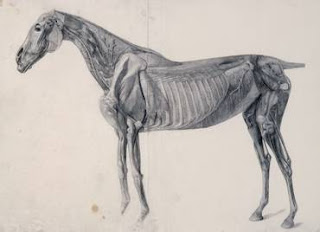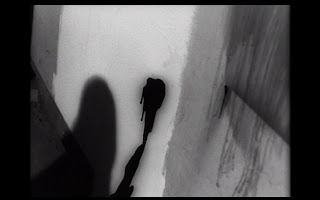[This is the talk I gave yesterday at the HM conference in London. It represents an incomplete account of a lot of the questions at hand; it is, rather, a provocation to thought about how to move through the melancholia of the radical left now, how to not retreat in the closing off of our "nightmare history" by mourning, how to make something other of this apparent impasse.]
The manifesto, as form, is the speaking of a
we that does not exist prior to its articulation. A we
that holds out in thought, but not yet a
who, not yet an
us. There lies its uncanny time: it claims to make manifest, to make public, that which can no longer be ignored.
A spectre is haunting Europe. But what was this spectre? It was, precisely, the dark cloud of proletarian uprising that had no shape until it gathered storm in the course of the
Communist Manifesto itself. The spectre of Communism is never merely the spectre of dissent: it is the directionality of that dissent, the consolidation of enmity to its crucial basic antagonisms, laid bare in the cross-fire of proletarian theory and bourgeois ideology.
As such, the spectre of Communism arises only at the end of the manifesto, in the call:
Workers of the world, Unite! The looming presence of Communism that haunts Europe – and the text of the Manifesto itself – is created retroactively, based on the articulated conditions (“the history of all hitherto existing societies is the history of class struggle”) and the conditions of articulation (“The Communists disdain to conceal their views and aims”). In other words, the call to unite – a call conditioned by the fact that Europe is already haunted by the coming violence of proletarian revolution – is a sort of short-circuit, a negative feedback loop in the text. Though we must insist: this is no failure of the Manifesto. It is its conceptual and practical triumph.
Only with Marx’s
18th Brumaire of Louis Napoleon, written four years later, do we get the expression, however fleeting, of what is at stake in this untimely logic, in how it seems to be both creating a new
we and, conversely, giving voice to the swelling ranks of a
we that has yet to find a voice. Yet this “seems” remains deceptive, for it is precisely in that perspectival slippage that we find its radical point of departure – its hard political kernel – and our point of departure, for imitating differently, such a gesture now.
The expressive project of the
Manifesto, as distinct from – yet bound to – its political project, is laid out in the
18th Brumaire:
“The social revolution of the nineteenth century cannot draw its poetry from the past, but only from the future. It cannot begin with itself, before it has stripped off all superstition in regard to the past.”
Where previous revolutionary movements needed the radical triumphs of the past to glorify and buttress the historical validity of their moments – a claiming of lineage with revolts of the past – the time has come, for Marx in the mid 19th century, to force a break in this assumed continuity. The Communist offense must begin
with itself, not with its predecessors, for it is those predecessors – reduced to superstitious, mythicized events – that both overdetermine and limit the capacity to act in the present.
This is, for Marx, a problem of the weight of inherited forms: past tactics, bloody icons, and, to détourne Robespierre’s words, “revolution without a revolution”, a lifeless, crystallized historical shape. Marx writes,
“In order to arrive at its content, the revolution of the nineteenth century must let the dead bury their dead. There the phrase went beyond the content; here the content goes beyond the phrase.”
What is this dialectic of content and phrase? It is this: previous manifestos, prior articulations of revolutionary becoming, had an excess of “phrase” beyond their content. As such, they remained at once utopian and restricted in their vision: blueprints for political action without the “content” of developing proletarian consciousness.
Writing in 1852, after the incendiary years of the late 40’s and the repressive closure of that opening, the situation is different. There was a spilling over of uncontained “content,” of working class dissent and enmity. What was lacking was a phrase adequate to give shape: not to dictate how such revolutionary affect should be but rather to give direction to it, to focus it toward the chinks in the armor of the consolidating state forms and industrial might of Europe. How, then, is this remedied? By letting the “dead bury the dead,” of refusing to look to the continuation of past struggles as the constant site of battle, of no longer borrowing forms that once were adequate. In short, with
the poetry of the future.
Poetry, here, is not an accidental designation: it is precisely the question of a poetics of experimental form, of avant-garde politics, rethinking not only what revolution looks like to us but how revolution should look, how it should see, and how it understands the historical conjuncture in which it unfolds and which it makes unfold. The question is a need to rethink the phrase, as in phrasing in singing: how do we give form to breath, that which is needed as the content-to-be.
To speak of this moment now, not of 1852, must still be to speak, unapologetically, of a
we. Against pluralism, against obsessive identity particulars, against an assumption of determinate, fixed commonalities. Or better, not to speak
of a we, for it is worth noting that in the Communist Manifesto, “we” is rarely used to speak as the proletariat – it functions more a placeholder for we, the knowing reader. It takes Lenin to fully make the move, in
What is to be Done, to forcefully integrate the reader into the position of the radical we, the revolutionary party.
Not to speak
of a we, then, but to grasp that speaking a
we is not the same thing as describing an already existing
us to which one may or may not belong. This failure, this slippage in articulation, produces very real consequences not only in how to think about what we – as a revolutionary movement – look like but what the enemy looks like, how we think capitalism itself.
This is the very failure that haunts certain workerist – and post-workerist – models of the “socialized worker” (
operaio sociale). Developed initially by Alquati and adopted by Negri, Lazzarato, and other theorists of the “post-Fordist turn,” the notion is now familiar to us: in the 60’s and 70’s, the increasing abstraction of labor, confronted with the factory struggles and strikes of the worker’s movement, resulted in the development of increasingly socialized labor no longer limited to particular sites of work that had become, equally, sites of resistance. Developed outside the immediate processes – and changes within – the production system, the socialized worker is not tied to a single sector; as such, it is the proletarian subject of abstract labor constituted across the process of valorization itself, the zero sum of the post-Fordist global system. We can detect this figure of socialized labor as the broader base beneath other current forms of labor: immaterial labor, service sector work, information technology, “precarious” off-site work. We are concerned here neither with the accuracy of designating this as the dominant figure of late capitalism nor with the important work done by
operaismo theorists in grasping new valences of accumulation, circulation, and domination.
Our concern is the political potential Negri located in the socialized worker. His thesis, one that has continued to unfold into
Empire, is that the mutations of capitalist restructuration did not result in the collapse of proletarian political potential. He strains, as it were, against the reactionary conclusions regarding the end of radical politics. Instead, he argues in
Proletari e Stato, there is an unintended consequence to the new political composition of the working classes, the unification in the form of socialized labor: there is, “a single law of exploitation present over the entire process of planning of capitalist society.”
What is the problem with this, from the perspective of new struggles against capitalism? The fundamental problem is the flattening of capital, through the generalized figure of the socialized worker. For we cannot claim that we have revolutionary potential because there is now a generalization – by capital – of diverse workers into the socialized worker subject. The proletariat must be instead the universalization of radical difference, not the consequence of capital “flattening” the world and colonizing the whole life world of the worker. To speak the
we, in the model we detected in the circuits of the
Communist Manifesto, is to insist against the tendency that says “we are already a we”, a multitude of socialized workers.
But who is the we that speaks now? Who is the we that must be articulated so as to produce, out of the field of disparate antagonisms, its retroactive necessity, the figure of its threat so we can begin from there?
The time of the great struggles, of emergent moments of the revolutionary Event, is supposed to have passed. Yet counter-intuitively, we should in fact insist on this position, on the constitutive anxiety that forms the core of the revolutionary position today. We speak from a position of anxiety, and it would seem that this is anxiety about the “absence of revolutionary potential,” anxiety about the “end of politics,” anxiety about the past tradition we seem incapable of resurrecting. Have we lost, irrevocably, the horizon, the thinkability of Communism?
This would be a misreading. Anxiety here means neither our nervousness about the unknowability of the future nor the creeping fear that such a future is all too knowable. Rather, anxiety, following Lacan in his tenth seminar, is “the lack of a lack.” Our problem is not that we lack the sort of explosive antagonisms and radical potential we once had, but that we suffer from
too many, too much. Not a lack of crisis-moments, but their excess, and this field of waste, of chances slipping past us, this lack of lack makes it difficult to clear the necessary space to recognize what is crucial. We assume that repression is like pornography:
I know it when I see it, that there will be a moment where suddenly naked power shows itself fully, and we receive, from the development of capital toward its tendential crises, coordinates for our action. Yet this injunction should be reversed:
I know it when I can’t see it. We detect coercion where it seems most absent. This is old heart of Marxist ideological critique: it is from the “purely” economic that the repressive circuit of capitalist social codes begins, the central germ of antagonism and domination. This core of cultural critique must be maintained, all the more revived today, in order to cut away and reveal the subversive and productive force of starting from anxiety, moving toward and through the fear of repetition.
We think from this position of anxiety, and it is from here that we need to articulate a we capable of negation, and the space of lack in which real political desire can find its targets and objects. As such, the project seems to be ever more that of the
18th Brumaire, letting the dead bury the dead and “focusing on the new.” This would be – and perhaps has been – our fundamental mistake. I cannot judge how accurate those judgments of the
Brumaire were for the mid 19th century. But to speak for now: we might insist – against the fetishization of the unforeseen and unthinkable new –that we need to unbury the dead, not to resurrect them as messianic visions, but to detect, in their very undeadness, a sense of how the imitation of politics was and is our most radical gesture. Marx writes,
“Men make their own history, but they do not make it just as they please; they do not make it under circumstances chosen by themselves, but under circumstances directly found, given and transmitted from the past. The tradition of all the dead generations weighs like a nightmare upon the brain of the living.”
What allows us to speak the
we, to conceive of directed political action toward the future?
It is precisely this nightmare weight of the past. What conditions the emergence of that call – workers of the world, unite – is the dead of our history, out from under whose mass and through whose singular, repeated failures comes something like a spectre.
But we should not obsess so much over ghosts, or take them too literally as our model. Marx again provides a way from here:
“The awakening of the dead in those revolutions therefore served the purpose of glorifying the new struggles, not of parodying the old; of magnifying the given tasks in imagination, not of taking flight from their solution in reality; of finding once more the spirit of revolution, not of making the ghost walk again.”
The particular wording is crucial here: to make the ghost walk
again. Not to wake the dead – that which once was organic and living – as a ghost, but to make the
ghost walk again. Is it not the case, then, that what is at stake here is precisely not resurrection but repetition? What Marx warned against for the revolution of the 19th century may be the very needed rallying cry for our revolution: a recognition that the spirit of revolution has always been a ghost, or perhaps the endless reanimation of its acting body, a repetition gone wrong. Most precisely, a thought of politics not as something that once was “really alive” but instead as the inhuman imitation that, in getting it wrong, gets it right.
This is to say: revolutionary politics – in its strategies, tactics, and imaginings – imitates the New, the Evental. Such tactics and orientations are based on our slippages, failures, unexpected gains: the moments where the reigning order displays the lie of its seeming permanence. Even without a tinge of revolutionary romanticism, we necessarily – and this we includes those like Negri who accuse comrades of worshipping the “whore of continuity – hail the moments of rupture, the great events, the lost causes. But we cannot simply defend them as the triumph belonging to “another age,” some time when massive structural change was possible. Such change is always unthinkable: that is the point. We cannot defend a lost cause – we can only become its offense. And, perhaps, insist on the lost cause as the central figure of radical thought today. This is the recognition that, as Zizek puts it, “What we are unable to repeat, we are haunted by and are compelled to remember.” This should be supplemented to say: what we cannot fathom repeating - what we think of as the incommensurable New of past revolutionary moments, we are compelled to remember, to consign either to the dead and buried, or to the resurrectional promise that never will be.
This means: the New is itself a repetition, in its moments of emergence, before it has the character as that which inaugurates an order. It is the retroactive symptom – which we inevitably fail to grasp in our symbolic version as the New, the representation of what we tell ourselves cannot be represented – of a politics of imitation. Imitation has negative undertones, but maybe in more ways than one, and hence the need to embrace it. It undoes the banal fantasies of a humanist subject blazing a new path of action from an analytical cogito. And more than that, it is the needed figure of negation, of how we work through anxiety: we do not remember, we repeat. But we repeat in a gesture of militancy: we imitate.
Here, then, we need to ask: what does this militant repetition look like, and how does it stand against both capitalist totality and political conjunctures? It is – and can only be – a politics of the vanguard, a self-consumptive, self-effacing vanguard, the dark precursor of revolution. For in capitalism, we face a fundamental non-dialectical Two, a false opposition that constitutes the limits of how capital articulates, adapts, and advances itself:
there is capital, and there is that which can become capital. Such is the totalizing vision of the logic of the value-form. Yet to think through Lacan’s formula for the missing third in an apparent opposition (1 + 1 + a or 1 + 1 = 3), we see precisely the equation of this non-dialectical Two and its excluded core, eliding the true antagonism: between capital and
that which never can be capital. This is the hard kernel of the enmity capitalism generates, the basic fact of exploitation. Yet that which forms the basis of our resistance also creates the distortion and tension that makes it so difficult to transition from a recognition that something is very wrong to a confrontation with the fundamental principle of distortion. As Zizek writes,
“it is wrong to say that the “central” social antagonism (“class struggle”) is always expressed/articulated in a distorted/displaced way: it is the very principle of this distortion.”
We might think this further and say: this unseeable thing – not the real, material effects of exploitation but the abstract logic of abstract exploitation, the form itself of the commodification of human labor – this is at once the object which we need in our struggle yet cannot find, and the obstacle that makes such access so difficult. At once the missing object and the cause of its missingness.
But as we said of both the perspectival slippage of the
we of the
Communist Manifesto and the paralysis of anxiety, so too can be said here: the apparent overdetermination and failure of these positions – their very nature as lost causes – is precisely where they gain their radical force. For it is this perspectival slippage itself, between that which cannot be capital as missing from our sight and as blocking our sight, that produces the dizzying blur of overdeterminations, of the too-many apparent “central antagonisms” that put us in a position of anxiety. Here, though, is the crucial point: this true opposition is – like a politics that never had its originary, living content – uncanny, inaccessible. Unlike our chances for militant politics, this heart of capital never “exceeds the phrase with its content”: it is pure phrase, an opposition without content, the basic architecture of the abstraction of value. To stare it in the face, to try and act in the space between this inhuman logic and the real human consequences, is to stand in a position of anamorphosis, of distortion. The whole picture, so to speak, is lost.
Again, though, this might be a point of departure, rather than the closure of possibilities. What we would need, then, is a way to ourselves stand in that position of distortion, in that uncanny spot between two radically opposed ways of seeing, two sets of symptoms and consequences and effects that seem incompatible, even though we know their intimate connection. Such knowing is not priviledged to Marxists or specialized thinkers of anti-capitalism. It is the general knowing – one could say the general anti-intellect – of all subjects of capital:
je sais bien, mais quand meme… I know very well, but all the same… To end, then, is to call for a position of the vanguard as a dark precursor, that vanishing mediator which by virtue of its own power (or perhaps, the power of its
virtú), acts as the fuse-point, the immediate contact, between these two series of apparently incommensurable effects. The vanguard, in this sense, is the point of passage between two worlds: the spectral architecture of capitalism, and the enacted terrain of worker struggle. The
we that speaks here is precisely that missing object, the point that emerges to close a gap, a gap not only between two directions of vision (capitalist development and the history of the working class) but also between two political sequences, bourgeois and revolutionary. Our vital point then, following this concept of the dark precursor, is that this vanishing mediator creates the effects of resemblance: it is precisely not the retroactive vision that, “oh, indeed, here was a point of similarity”. It is the symptom of the incompatibility of these two political worlds, the symptom that makes it possible for one to conquer the other. The history of capitalism is primarily the history of capitalist development dominating its laboring bodies. But through the point of the vanishing vanguard, it becomes possible, to imitate a well-known phrase,
to storm heaven, to collapse the political and economic into points of struggle.
In his late film
In girum imus nocte et consumimur igni, Debord speaks the following:
“But theories are only made to die in the war of time. Like military units, they must be sent into battle at the right moment; and whatever their merits or insufficiencies, they can only be used if they are on hand when they’re needed. They have to be replaced because they are constantly being rendered obsolete – by their decisive victories even more than by their partial defeats.”
This is the vanguard that we have been without knowing it, the embodiment of theory made to die in the war of time and the time of war. We cannot desire to be the permanent principle of where we go from the dismantling of capitalism. What we must desire is to imitate through distortion, to bring about the New by welcoming the weight of anxiety, by turning what feels to be a cursed inheritance into a tactics of repetition, of insisting on a speakable, militant, and undigestable we in the face of capital’s endless smoothing-out of the world. We have been turning our history against ourselves, split between the catastrophes that we should avoid and the emergent Events we cannot repeat. This is a sad history, but one to be repeated into a productive point, not remembered and mourned. For history may be cunning. But, after all, so are we.
























